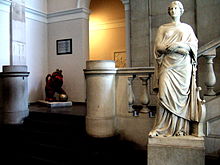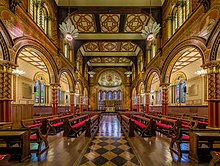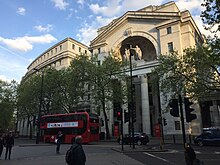
Bath is a city and unparished area in the Bath and North East Somerset unitary area in the ceremonial county of Somerset, England, known for and named after its Roman-built baths. At the 2021 Census, the population was 101,557. Bath is in the valley of the River Avon, 97 miles (156 km) west of London and 11 miles (18 km) southeast of Bristol. The city became a World Heritage Site in 1987, and was later added to the transnational World Heritage Site known as the "Great Spa Towns of Europe" in 2021. Bath is also the largest city and settlement in Somerset.

Sir William Chambers was a Swedish-Scottish architect, based in London. Among his best-known works are Somerset House, and the pagoda at Kew. Chambers was a founder member of the Royal Academy.

King's College London is a public research university located in London, England. King's was established by royal charter in 1829 under the patronage of King George IV and the Duke of Wellington. In 1836, King's became one of the two founding colleges of the University of London. It is one of the oldest university-level institutions in England. In the late 20th century, King's grew through a series of mergers, including with Queen Elizabeth College and Chelsea College of Science and Technology, the Institute of Psychiatry, the United Medical and Dental Schools of Guy's and St Thomas' Hospitals and the Florence Nightingale School of Nursing and Midwifery.

Aldwych is a closed station on the London Underground, located in the City of Westminster in Central London. It was opened in 1907 with the name Strand, after the street on which it is located. It was the terminus of the short Piccadilly line branch from Holborn that was a relic of the merger of two railway schemes. The station building is close to the Strand's junction with Surrey Street, near Aldwych. During its lifetime, the branch was the subject of a number of unrealised extension proposals that would have seen the tunnels through the station extended southwards, usually to Waterloo.

Strand is a major thoroughfare in the City of Westminster, Central London. The street, which is part of London's West End theatreland, runs just over 3⁄4 mile (1.2 km) from Trafalgar Square eastwards to Temple Bar, where the road becomes Fleet Street in the City of London, and is part of the A4, a main road running west from inner London.

Edward Middleton Barry RA was an English architect of the 19th century.

Aldwych is a street and the name of the area immediately surrounding it, in central London, England. It is located in the City of Westminster, and is part of London's West End Theatreland. The 450 metres (1,480 ft) street starts 600 metres (2,000 ft) east-northeast of Charing Cross, the conventional map centre-point of the city.
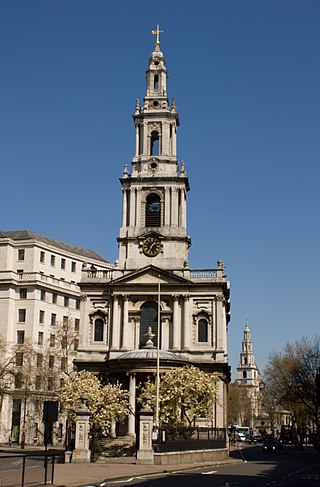
St Mary le Strand is a Church of England church at the eastern end of the Strand in the City of Westminster, London. It lies within the Deanery of Westminster within the Diocese of London. The church stands on what was until recently a traffic island to the north of Somerset House, King's College London's Strand campus, and south of Bush House. It is the official church of the Women's Royal Naval Service, and has a book of remembrance for members who have died in service. The nearest tube station is Temple, with the now-closed Aldwych station nearly opposite the church. It is known as one of the two 'Island Churches', the other being St Clement Danes.

Somerset House is a large Neoclassical complex situated on the south side of the Strand in central London, overlooking the River Thames, just east of Waterloo Bridge. The Georgian era quadrangle was built on the site of a Tudor palace originally belonging to the Duke of Somerset. The present Somerset House was designed by Sir William Chambers, begun in 1776, and was further extended with Victorian era outer wings to the east and west in 1831 and 1856 respectively. The site of Somerset House stood directly on the River Thames until the Victoria Embankment parkway was built in the late 1860s.

Bush House is a Grade II listed building at the southern end of Kingsway between Aldwych and the Strand in London. It was conceived as a major new trade centre by American industrialist Irving T. Bush, and commissioned, designed, funded, and constructed under his direction. The design was approved in 1919, work began in 1925, and was completed in 1935. Erected in stages, by 1929 Bush House was already declared the "most expensive building in the world".

Sir William Tite was an English architect who twice served as President of the Royal Institute of British Architects. He was particularly associated with various London buildings, with railway stations and cemetery projects. He was the Member of Parliament (MP) for Bath from 1855 until his death.
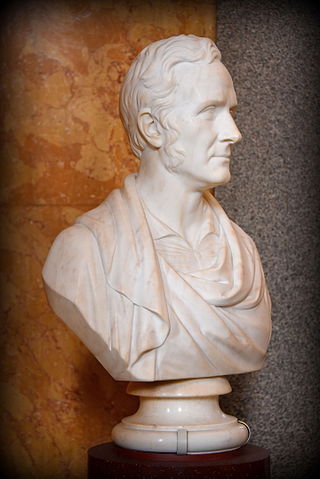
Sir Robert Smirke was an English architect, one of the leaders of Greek Revival architecture, though he also used other architectural styles. As architect to the Board of Works, he designed several major public buildings, including the main block and façade of the British Museum. He was a pioneer of the use of concrete foundations.

King's College London Students' Union (KCLSU) is an independent charitable organisation that's works to further the interests of its members. It governs the 300 student societies and activity groups at King's. KCLSU claims to be the oldest students' union in England.

The Maughan Library is the main university research library of King's College London, forming part of the Strand Campus. A 19th-century neo-Gothic building located on Chancery Lane in the City of London, it was formerly the home to the headquarters of the Public Record Office, known as the "strong-box of the Empire", and was acquired by the university in 2001. Following a £35m renovation designed by Gaunt Francis Architects, the Maughan is the largest new university library in the United Kingdom since World War II.
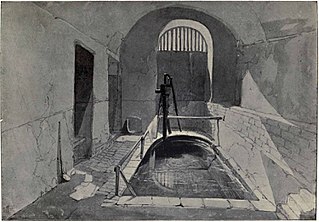
The Strand Lane Baths, at 5 Strand Lane, London WC2R 2NA, have been reputed since the 1830s to be a Roman survival. They are in fact the remaining portion of a cistern built in 1612 to feed a fountain in the gardens of the old Somerset House, then a royal place. After a long period of neglect and decay, following the demolition of the fountain, they were brought back into use in the 1770s as a public cold plunge bath, attached to No. 33 Surrey Street. The idea that they were Roman probably began some fifty years later as an advertising gimmick, and has aroused both enthusiasm and scepticism ever since.
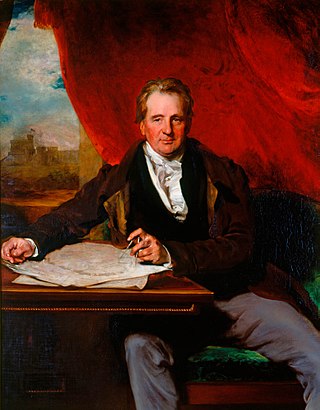
Sir Jeffry Wyatville was an English architect and garden designer. Born Jeffry Wyatt into an established dynasty of architects, in 1824 he was allowed by King George IV to change his surname to Wyatville. He is mainly remembered for making alterations and extensions to Chatsworth House and Windsor Castle.

The Chapel of King's College London is a Grade I listed 19th century chapel located in the Strand Campus of King's College, London, England. Originally designed by Sir Robert Smirke in 1831, the Renaissance Revival chapel seen today was redesigned by the prominent Victorian Gothic architect Sir George Gilbert Scott in 1864.
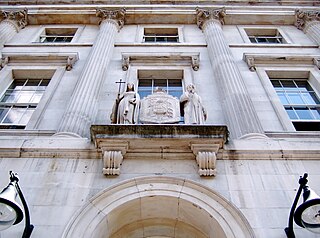
The King's Building is a Grade I listed building that forms part of the Strand Campus of King's College London in the United Kingdom. Originally named the College Building, the King's Building was designed by Sir Robert Smirke in the course of the College's foundation in 1829. As the founding building, it was built between 1829 and 1831 on land granted to King's College by the Government to complete the riverside frontage of Somerset House.
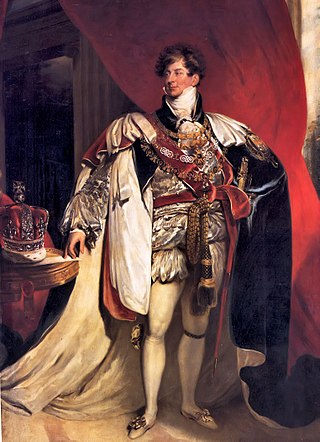
The history of King's College London, on its own, spans over 190 years since it was founded as a 'university college' by royal charter in 1829. However, its formation as a full 'university' would have to wait until 1836 as a part of the University of London. The full history, however, includes the medical schools that now constitute GKT School of Medical Education. This incorporates St Thomas's Hospital Medical School, one of the oldest medical schools in Britain, with a history of medical teaching that can be traced back to at least 1561. St Thomas' Hospital itself dates back to 1173, and has roots in the establishment of St Mary Overie Priory in 1106.

The Department of Classics is an academic division in the Faculty of Arts and Humanities at King's College London. It is one of the oldest university-level institutions specialising in the study of classical languages, literature, thought, religion, art, archaeology and ancient history in the United Kingdom.

